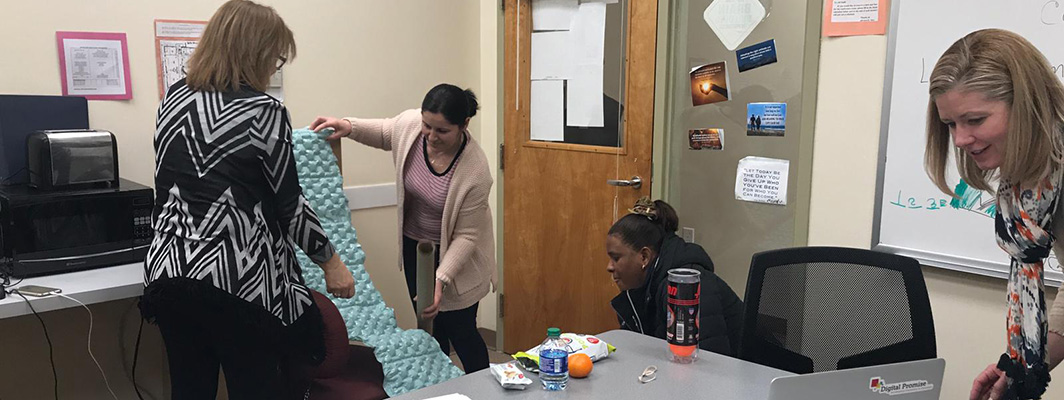
February 6, 2020 | By Ximena Dominguez
The same is true of education innovations. If our goal is to develop resources that are likely to be adopted at home or school and are consequential for learning, we must bring educators, families, researchers, and designers together to brainstorm, co-design, and research innovations. Our Early STEM team at Digital Promise is working towards this goal, and has learned some important lessons along the way.
One of the most important lessons we’ve learned is the need for documentation that clearly details the shared learning goals. For instance, what do we mean when we say we want to “develop resources to promote early math”? Is it for children to learn to count with one-to-one correspondence, identify shapes and their properties, or understand how to use standard tools to measure? Each of these goals can be further subdivided; for instance, if the goal is to use tools to measure, children may learn to place the ruler correctly, understand and identify the numeral that represents length, and to compare measurements. Clearly defining these learning goals helps articulate a shared understanding and provides everyone with common language. This “learning blueprint” can serve as an anchor document that can be referred to when resources are designed and reviewed, and when research tools are selected or created to evaluate outcomes.
We’ve noticed teachers sometimes feel that researchers hold more knowledge than they do on a domain of learning. Additionally, parents often view teachers as experts who know more than they do about how their children learn. Sometimes neither teachers nor parents see themselves as designers.
In our experience, it has been helpful to explicitly highlight the expertise each stakeholder uniquely contributes. For example, teachers are experts about what it’s like to be in the classroom, parents have a unique understanding of what may resonate with children’s everyday lives, designers know what is possible on the backends of apps, and researchers understand how children build knowledge and can collect data to make inferences about learning. Only by bringing each of these crucial perspectives and skill sets together can we design powerful and effective resources for early learners.
Brainstorming ideas in a group can be challenging, especially when tackling something new. For example, when our team began a project on computational thinking, stakeholders were often wary about sharing ideas on topics they were not yet confident about.
Plan to kick off your co-design project by sharing imperfect “seed ideas.” These sacrificial ideas may have obvious flaws, but the goal of sharing them is to improve the ideas as a group, and to facilitate conversations about why they may not work. For example, are these ideas not targeting a set learning goal; is it hard for parents to feasibly find the required materials at home; are designers finding it difficult to build an interface that would allow desired features? These conversations usually lead to the emergence of alternatives and help co-design groups get in the habit of thinking through challenges together.
The co-design approach involves giving and getting critical feedback along the way, which is not easy. Being on the receiving end of critical feedback can be exhausting and demotivating. Stakeholders involved in co-design must learn to communicate ideas and honest feedback while being responsive and kind.
It’s important to note it is common and normal to encounter design tensions when working together. For instance, a designer may be focused on how to keep children engaged, while a researcher is focused on how to ensure the activities are consequential for learning. Ultimately, a design solution that does both is better. When working in silos, designers may find researchers to be critical of the learning value of their products, and researchers find it hard to hear from experts in game design that their games are boring. Co-designing from the start increases the likelihood of striking a balance between usability, learning, and fun.
Co-design efforts require time and funds, as well as the flexibility to change course as needed. Designers often work much faster than researchers do. In order to strike a balance and for the process to be effective, researchers may need to be more nimble and designers may need to slow down to allow the processing of data to inform iterations. Involving educators and families may also require everyone to think creatively about when to schedule meetings and discussions. While co-design may require additional time and funds upfront, it is ultimately worth the investment as this approach centers the needs and experiences of the stakeholders closest to the learners we strive to support.
Learn more about our National Science Foundation-funded efforts to co-design innovations to promote early STEM learning across preschool and home, and discover Digital Promise’s vision for partnering with diverse stakeholders, “Designing a Process for Inclusive Innovation: A Radical Commitment to Equity”.
By Rastee Chaudhry and Barbara Pape
By Tamara Tate and Pati Ruiz